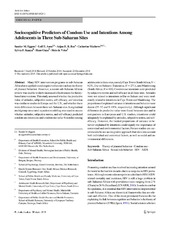| dc.contributor.author | Eggers, Sander M. | |
| dc.contributor.author | Aarø, Leif Edvard | |
| dc.contributor.author | Bos, Arjan E.R. | |
| dc.contributor.author | Mathews, Catherine | |
| dc.contributor.author | Kaaya, Sylvia | |
| dc.contributor.author | Onya, Hans | |
| dc.contributor.author | de Vries, Hein | |
| dc.date.accessioned | 2015-12-11T09:23:18Z | |
| dc.date.available | 2015-12-11T09:23:18Z | |
| dc.date.issued | 2015-04-30 | |
| dc.Published | Archives of Sexual Behavior 2015, Published ahead of print | eng |
| dc.identifier.issn | 1573-2800 | |
| dc.identifier.uri | https://hdl.handle.net/1956/10742 | |
| dc.description.abstract | Many HIV intervention programs in sub-Saharan Africa have applied social cognitive theories such as the theory of planned behavior. However, a recent sub-Saharan African review was unable to show increased effectiveness for theory-based interventions. This study assessed whether the predictive value of attitudes, subjective norms, self-efficacy, and intention was similar to studies in Europe and the U.S., and whether there were differences between three sub-Saharan sites. Longitudinal multigroup structural equation modeling was used to assess whether attitudes, subjective norms, and self-efficacy predicted condom use intentions and condom use (after 6 months) among adolescents in three sites, namely Cape Town (South Africa; N = 625), Dar es Salaam (Tanzania; N = 271), and Mankweng (South Africa; N = 404). Condom use intentions were predicted by subjective norms and self-efficacy in all three sites. Attitudes were not related to intentions in Dar es Salaam and were moderately related to intentions in Cape Town and Mankweng. The proportions of explained variance in intentions and behavior were decent (37–52 and 9–19 %, respectively). Although significant differences in predictive value were found between sites and in comparison to European and U.S. studies, intentions could adequately be explained by attitudes, subjective norms, and self-efficacy. However, the limited proportions of variance in behavior explained by intentions could signify the importance of contextual and environmental factors. Future studies are recommended to use an integrative approach that takes into account both individual and contextual factors, as well as social and environmental differences. | en_US |
| dc.language.iso | eng | eng |
| dc.publisher | Springer | eng |
| dc.rights | Attribution CC BY | eng |
| dc.rights.uri | http://creativecommons.org/licenses/by/4.0 | eng |
| dc.subject | Theory of planned behavior | eng |
| dc.subject | Condom use | eng |
| dc.subject | Sub-Saharan Africa | eng |
| dc.subject | Sexual risk behavior | eng |
| dc.subject | HIV | eng |
| dc.subject | AIDS | eng |
| dc.title | Sociocognitive Predictors of Condom Use and Intentions Among Adolescents in Three Sub-Saharan Sites | eng |
| dc.type | Peer reviewed | |
| dc.type | Journal article | |
| dc.date.updated | 2015-11-06T09:27:16Z | |
| dc.description.version | publishedVersion | |
| dc.rights.holder | Copyright The Author(s) 2015 | eng |
| dc.identifier.doi | https://doi.org/10.1007/s10508-015-0525-1 | |
| dc.identifier.cristin | 1249970 | |
| dc.subject.nsi | VDP::Medisinske Fag: 700 | |
| dc.subject.nsi | VDP::Medisinske fag: 700::Helsefag: 800::Forebyggende medisin: 804 | |
| dc.subject.nsi | VDP::Midical sciences: 700::Health sciences: 800::Preventive medicine: 804 | |
| dc.subject.nsi | VDP::Medisinske fag: 700::Helsefag: 800::Samfunnsmedisin, sosialmedisin: 801 | |
| dc.subject.nsi | VDP::Midical sciences: 700::Health sciences: 800::Community medicine, social medicine: 801 | |

